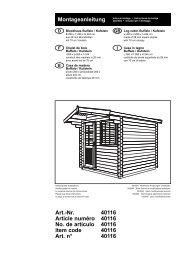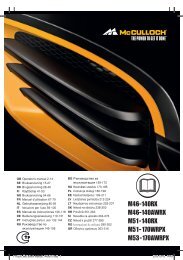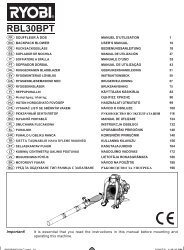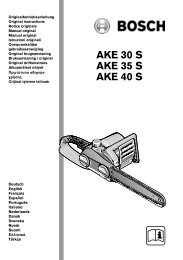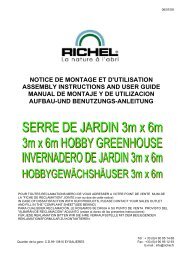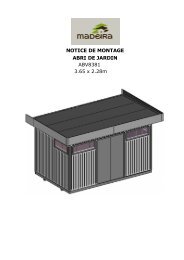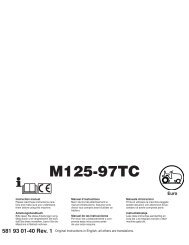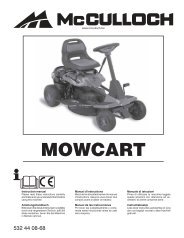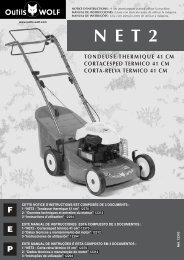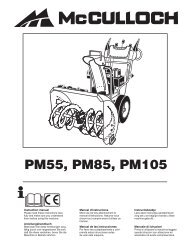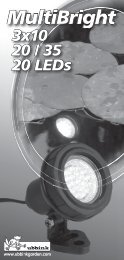RcS3535B/RcS3535cB/RcS4040cB - Plantes et Jardins
RcS3535B/RcS3535cB/RcS4040cB - Plantes et Jardins
RcS3535B/RcS3535cB/RcS4040cB - Plantes et Jardins
You also want an ePaper? Increase the reach of your titles
YUMPU automatically turns print PDFs into web optimized ePapers that Google loves.
FR EN DE ES IT PT NL SV DA NO FI HU CS RU RO PL SL HR ET LT LV SK BG<br />
FR EN DE ES IT PT NL SV DA NO FI<br />
DE<br />
FR EN ES IT PT NL SV DA NO FI<br />
ES<br />
HU CS RU RO PL SL HR<br />
English<br />
HU CS RU RO PL SL HR<br />
FR EN DE IT PT NL SV DA NO FI HU CS RU RO PL SL HR ET LT LV SK BG<br />
FR<br />
FR<br />
FR<br />
WARNINg:<br />
manner.<br />
ENSee DEFigure ES 20IT<br />
PT NL SV DA NO FI HUOPERATION CS RU RO PL SL HR ET LT LV SK BG<br />
DO NOT operate the throttle trigger with your left<br />
FELLINg TREES IN HAZARdOuS CONdITIONS<br />
ENhand DE and ES hold IT the PT front NL handle SV with DA your NO right FI HU CS RU RO PL SL HR ET LT LV SK BG<br />
WARNINg:<br />
hand. Never allow any part of your body to be in<br />
Do not fell trees during periods of high wind or<br />
ENthe DE chain ESline IT while PToperating NL a SV saw. DA NO FI HU CS RU RO PL SL HR ET LT LV SK BG<br />
heavy rain. Wait until the hazardous weather<br />
has ended. When felling a tree, it is important<br />
PROPER FR EN CuTTINg DE ES STANCE IT PT NL SV DA NO FI HU CS RU RO PL SL HR ET LT LV SK BG<br />
that you heed the following warnings to prevent<br />
See Figure 21.<br />
possible serious injury.<br />
■ FRBalance EN DE your ES weight IT with PT both NLfe<strong>et</strong> SVon solid DA ground. NO FI HU CS RU RO PL SL HR ET LT LV SK BG<br />
■ Do not cut down trees having extreme lean or large<br />
■ Keep left arm with elbow locked in a “straight arm”<br />
trees with rotten limbs, loose bark, or hollow trunks.<br />
FRposition EN DE to withstand ES IT any PTkickback NL SVforce. DA NO FI HU CS RU RO PL SL HR ET LT LV SK BG<br />
Have these trees pushed or dragged down with<br />
■ Keep your body to the left of the chain line.<br />
heavy equipment, then cut them up.<br />
■ FRKeep EN your DE thumb ES on IT underside PT NL of SV handlebar. DA NO FI HU CS RU RO PL SL HR ET LT LV SK BG<br />
■ Do not cut trees near electrical wires or buildings.<br />
WORk FR ENAREA DE PRECAuTIONS<br />
ES IT PT NL SV DA NO FI<br />
■ HU CS Check RU the ROtree PLfor SL damaged HR ET or dead LT branches LV SK BG that<br />
See Figure 22.<br />
could fall and hit you during felling.<br />
■ FRCut ENonly DEwood ES or IT materials PT NL made SVfrom DAwood NO FI HU ■ CSPeriodically<br />
RU ROglance PL SL at the HRtop<br />
ETof the LT tree LV during SK BG the<br />
■ Never allow children to operate the saw. Do not Allow back cut to assure the tree is going to fall in the<br />
FRpersons EN DE to use ES this IT chainsaw PT NLwho SVhave DA not NOread FIthis<br />
HU CS desired RU direction. RO PL SL HR ET LT LV SK BG<br />
operator’s manual or received adequate instructions ■ If the tree starts to fall in the wrong direction, or if the<br />
FRfor EN the safe DE and ES proper IT PT use of NLthis SVchainsaw. DA NO FI HU CS saw RUg<strong>et</strong>s ROcaught<br />
PLor SL hung HR up during ET LTthe LV fall, leave SK BG the<br />
■ Keep helpers, bystanders, children, and animals, saw and save yourself!<br />
FRa SAFE EN DEdISTANCE ES IT from PT NL the cutting SV DAarea. NO During FI HU CS RU RO PL SL HR ET LT LV SK BG<br />
felling operations, the safe distance should be a least<br />
FRtwice EN the DEheight ES of ITthe PT largest NLtrees SV in DA the felling NO FI area. HU<br />
During bucking operations, keep a minimum distance<br />
FRof EN 5 m<strong>et</strong>res DE b<strong>et</strong>ween ES IT workers. PT NL SV DA NO FI HU<br />
■ Always cut with both fe<strong>et</strong> on solid ground to prevent<br />
FRbeing EN pulled DE ES off balance. IT PT NL SV DA NO FI HU<br />
■ Do not cut above chest height as a saw held higher is<br />
FRdifficult EN DE to control ES against IT PTkickback NL SVforces. DA NO FI HU<br />
■ Do not fell trees near electrical wires or buildings.<br />
FRLeave EN this DE operation ES IT for PTprofessionals. NL SV DA NO FI HU<br />
PROPER PROCEduRE FOR TREE<br />
CS RU RO PL SL HR ET LT LV SK BG<br />
FElling<br />
See<br />
CS<br />
Figures<br />
RU RO<br />
23<br />
PL<br />
- 26.<br />
SL HR ET LT LV SK BG<br />
■ Pick your escape route (or routes in case the<br />
CS intended RU RO route PL SL is blocked). HR ETClear LT the LV immediate SK BG<br />
area around the tree and make sure there are no<br />
CS obstructions RU RO PLin your SL HR planned ET path LT of r<strong>et</strong>reat. LV SK Clear BG<br />
the path of safe r<strong>et</strong>reat approximately 135° from the<br />
CS planned RU ROline PL of fall. SL HR ET LT LV SK BG<br />
■ Cut only when visibility and light are adequate for you<br />
FRto EN see clearly. DE ES IT PT NL SV DA NO FI HU<br />
■ Consider the force and direction of the wind, the lean<br />
CS and RUbalance RO PLof the SL tree, HR ET and the LT location LV SKof<br />
large BG<br />
BASIC FR ENOPERATINg/CuTTINg DE ES IT PT NL SV DA NO FI HU<br />
limbs. These things influence the direction in which<br />
CS RU RO PL SL HR ET LT LV SK<br />
PROCEduRES<br />
Practice cutting a few small logs using the following<br />
technique to g<strong>et</strong> the “feel” of using the saw before you<br />
begin a major sawing operation.<br />
■ Take the proper stance in front of the wood with the<br />
saw idling.<br />
■ Accelerate the engine to full throttle just before<br />
entering the cut by squeezing the throttle trigger.<br />
■ Begin cutting with the saw against the log.<br />
■ Keep the engine at full throttle the entire time you are<br />
cutting.<br />
■ Allow the chain to cut for you; exert only light<br />
downward pressure. Forcing the cut could result in<br />
damage to the bar, chain, or engine.<br />
■ Release the throttle trigger as soon as the cut is<br />
compl<strong>et</strong>ed allowing the engine to idle. Running the<br />
saw at full throttle without a cutting load can result in<br />
unnecessary wear to the chain, bar, and engine.<br />
■ Do not put pressure on the saw at the end of the<br />
cut as this may cause the saw to drop in an unsafe<br />
39<br />
ET LT LV SK BG<br />
ET LT LV SK BG<br />
BG<br />
the tree will fall. Do not try to fell a tree along a line<br />
different from its natural line of fall.<br />
■ Cut a notch about 1/3 the diam<strong>et</strong>er of the trunk in the<br />
side of the tree. Make the notch cuts so they intersect<br />
at a right angle to the line of fall. This notch should<br />
be cleaned out to leave a straight line. To keep the<br />
weight of the wood off the saw, always make the<br />
lower cut of the notch before the upper cut.<br />
■ Make the back cut level and horizontal, and at a<br />
minimum of 2 in. above the horizontal cut of the<br />
notch.<br />
Note: Never cut through to the notch. Always leave<br />
a band of wood b<strong>et</strong>ween the notch and back cut<br />
(approximately 2 in. or 1/10 the diam<strong>et</strong>er of the tree).<br />
This is called a “hinge” or “hinge wood.” It controls<br />
the fall of the tree and prevents slipping or twisting or<br />
shoot back of the tree off the stump.<br />
■ On large diam<strong>et</strong>er trees, stop the back cut before<br />
it is deep enough for the tree to either fall or s<strong>et</strong>tle



